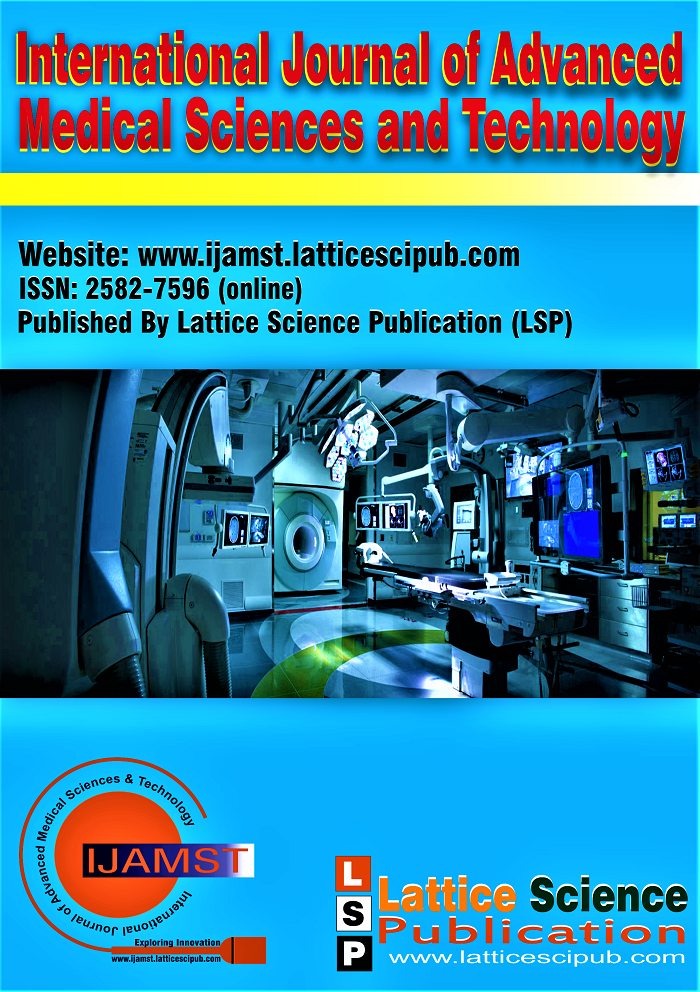Combined Techniques for Bilateral Maxillary and Nasal Reconstruction After Ablative Surgery for Adenoid Cystic Carcinoma
Main Article Content
Abstract
Indolent tumor growth up to large tumor masses and broad infiltration of surrounding tissue are the most typical characteristics of malignant tumors of the nasal cavity and paranasal sinuses. If surgery is a therapeutic option, extended resections and complex reconstruction modalities have to be taken into account. We present a combination of different reconstruction techniques to restore midface integrity after bilateral maxillectomy, including parts of the nasal skeleton, for adenoid cystic carcinoma. After obtaining tumor-free margins, reconstruction was performed using a microvascular double-flap technique to achieve a neo-maxilla and soft tissue lining of the oral cavity, dental implantology with prosthetic restoration and the insertion of a patient-specific implant for nasal re-shaping and stability. In cases of extended maxillary resection, a combination of different techniques can achieve sufficient functional and aesthetic rehabilitation, and restore quality of life. Further studies are warranted to evaluate the long-term stability of such complex reconstructions. However, local tumor control remains the highest priority and will be essential for years.
Downloads
Article Details

This work is licensed under a Creative Commons Attribution-NonCommercial-NoDerivatives 4.0 International License.
How to Cite
References
Rhee CS, Won TB, Lee CH, et al. Adenoid cystic carcinoma of the sinonasal tract: treatment results. Laryngoscope 116: 982-986, 2006.
Graça SAR, Sequeira H, Coelho G, et al. Adenoid cystic carcinoma of head and neck: apropos of a case. BMJ Case Reports. https://doi.org/10.1136/bcr-02-2012-5914, 2012.
He S, Li P, Zhong Q, Hou L, et al. Clinicopathologic and prognostic factors in adenoid cystic carcinoma of head and neck minor salivary glands: A clinical analysis of 130 cases. Am J Otolaryngol 38: 157-62, 2017.
Ellington CL, Goodman M, Kono SA, et al. Adenoid cystic carcinoma of the head and neck. Incidence and survival trends based on 1973–2007 surveillance, epidemiology, and end results data. Cancer 118: 4444-51, 2012.
Xu MJ, Wu TJ, van Zante A, et al. Mortality risk after clinical management of recurrent and metastatic adenoid cystic carcinoma. Journal of Otolaryngology - Head &Neck Surgery. https:// doi.org/10.1186/s40463-018-0273-z, 2018.
Lahjaouj M, Berrada O, Rayhane A, et al. Advanced adenoid cystic carcinoma of maxillary sinus: Rare case report and review of literature. Int J Surg Case Rep. https://doi.org/10.1016/j.ijscr.2021.02.008, 2021.
Rahmani K, Zahir ST, Yazdi MB, et al. Carcinoma of Maxillary Sinus in a 43-Year-Old Male: Rare Case Report and Review of Literature. Case Rep Med. https://doi.org/10.1155/2017/2324717, 2017.
Cordesmeyer R, Kauffmann P, Laskawi R, et al. The incidence of occult metastasis and the status of elective neck dissection in salivary adenoid cystic carcinoma: a single center study. Oral Surg Oral Med Oral Pathol Oral Radiol. https://doi:10.1016/j.oooo.2018.01.013, 2018.
Okay DJ, Genden E, Buchbinder D, et al. Prosthodontic guidelines for surgical reconstruction of the maxilla: a classification system of defects. J Prosthet Dent 86: 352-63, 2001.
Sari-Rieger A, Hassfeld S, Junker K, et al. Adenoid cystic carcinoma of the skull base mimicking temporomandibular disorder. Oral Maxillofac Surg 18: 115-8, 2014.
Joseph ST, Thankappan K, Buggaveeti R, et al. Challenges in the reconstruction of bilateral maxillectomy defects. J Oral Maxillofac Surg 73: 349-56, 2015.
Rustemeyer J, Melenberg A, Junker K, et al. Osteonecrosis of the maxilla related to long-standing methamphetamine abuse: a possible new aspect in the etiology of osteonecrosis of the jaw. Oral Maxillofac Surg 18: 237-41, 2014.
de la Parra M, Sanchez G, Lopez J, et al. Total maxillary reconstruction using a double-barreled and double skin paddle fibular flap after total maxillectomy. Arch Plast Surg 40: 779-82, 2013.
Ettinger KS, Nathan J, Guerrero LM, et al. Microvascular Reconstruction of Total Maxillary Avascular Necrosis as a Complication of Routine Orthognathic Surgery. J Oral Maxillofac Surg 78: 1846-58, 2020.
Kumar VV, Jacob PC, Ebenezer S, et al. Implant supported dental rehabilitation following segmental mandibular reconstruction- quality of life outcomes of a prospective randomized trial. J Craniomaxillofac Surg 44: 800-10, 2016.
Bahrami M, Falahchai SM. Full Mouth Reconstruction of a Skeletal Class II Division 1 Patient with Adenoid Cystic Carcinoma Using an Interim Immediate Obturator and a Definitive Obturator. Case Rep Dent. https:// doi.org/10.1155/2017/5458617, 2017.
Gueutier A, Kün-Darbois JD, Laccourreye L, et al. Anatomical and functional rehabilitation after total bilateral maxillectomy using a custom-made bone-anchored titanium prosthesis. Int J Oral Maxillofac Surg 49: 392-6, 2020.





